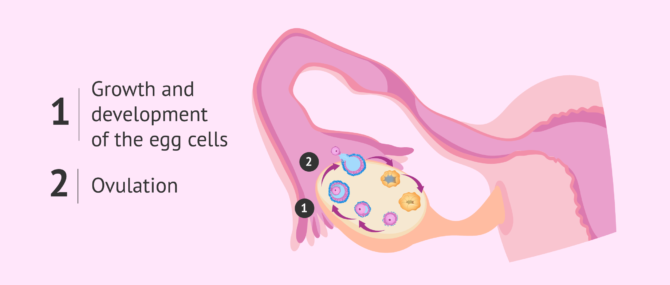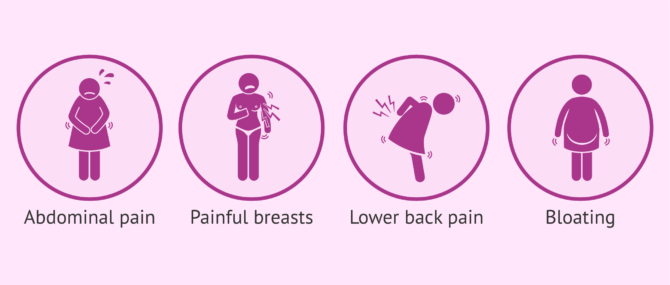Ovulation is the most fertile time in a woman's menstrual cycle. The ovulatory phase occurs approximately two weeks after menstruation and can cause discomfort similar to premenstrual symptoms. Some of them are painful breasts, headaches, pain in the kidneys or stomach. Some women also experience spotting during ovulation.
Medically, intermenstrual pelvic pain is known as Mittelschmerz. It is a German word meaning "middle pain", as it occurs in the middle of the female cycle. This type of pain is considered normal and is rarely severe. About 20% of women experience intermenstrual pelvic pain.
Provided below is an index with the 8 points we are going to expand on in this article.
- 1.
- 2.
- 3.
- 4.
- 4.1.
- 5.
- 5.1.
- 5.2.
- 5.3.
- 5.4.
- 5.5.
- 5.6.
- 5.7.
- 6.
- 7.
- 8.
What is ovulation?
Eggs develop in the ovary in a structures known as ovarian follicles. When an ovarian follicle is sufficiently developed, it ruptures and releases a mature egg into the Fallopian tube so that it can be fertilized.
The released egg remains in the Fallopian tube for approximately one or two days, waiting to be fertilized by a sperm. If fertilization does not occur, the egg will begin to disintegrate and the menstrual phase will begin.
Menstruation is nothing more than the shedding of a large part of the endometrium (uterine lining), which has been growing and preparing to nourish the embryo. Since pregnancy has not occurred, the endometrium is shed as bleeding, and a new cycle starts.
If you want to know more about ovulation, why not read this article: When does ovulation occur- what are the signs and symptoms of it?
Ovulation symptoms
Women who experience pain when ovulating often experience this discomfort in the lower abdomen. Often, ovarian pain during ovulation is felt on one side only, and depends on which ovary released the egg. There are those who ovulate every month from one ovary and those who ovulate for several months from the same ovary. This is highly variable between women and also between cycles of the same woman.
This pain between periods can last from a few hours to several days. In addition, in severe cases cramping and/or spotting or light bleeding may occur.
In addition to lower abdominal pain, other common symptoms during ovulation include the following:
- Discomfort, sensitivity or pain in the breasts
- Pain in the lumbar area at the level of the kidneys.
- Leg pain.
- Hip discomfort.
- Gases
- Muscular pain.
- Stomach ache.
- Joint pain.
- Bloating.
It should be noted that vaginal discharge changes throughout a woman's menstrual cycle. This is why when a woman is ovulating, her vaginal discharge increases and takes on an egg white-like appearance. In addition, the discharge during ovulation is usually whitish. These characteristics of the flow during the ovulatory phase help the movement of spermatozoa and, therefore, increase the probability of pregnancy.
What are the causes of ovulation pain?
There are several explanations for the origin of pain during ovulation. Some of them are listed below:
- Just before ovulation, follicle growth can distend the surface of the ovary and cause pain.
- At the time of ovulation, if the follicle enveloping the egg ruptures, blood may be released and it is believed that this may cause irritation of the abdominal lining, resulting in pain.
The presence of pelvic pain during ovulation may be severe, but it is not considered serious and does not indicate illness. In fact, women who present it may have advantages when planning or avoiding pregnancy, since the pain indicates the exact moment when they are ovulating, that is, the moment of greatest fertility.
A woman is more likely to become pregnant just before ovulation, on the day of ovulation, or immediately after ovulation. The ovum survives about 24 hours in the female reproductive tract once outside the follicle.
Treatment
Generally, no treatment is necessary for ovulatory pain, as it is not serious and does not cause great discomfort. However, there are situations in which ovulation pain is intense, sharp or extends over time. In these cases, painkillers can be taken.
Your doctor may also prescribe oral contraceptives to prevent ovulation and help reduce ovulation related pain. If you feel a lot of discomfort, you should visit your OB/GYN to perform a pelvic examination in case the cause of the discomfort is something else.
Home remedies for ovulatory pain
Many times, discomfort during ovulation is usually mild and temporary. This is why women prefer not to take anything and resort to home remedies.
First, the woman should remain relaxed and stretched out. Abdominal tension can mean the woman may feel more pain during ovulation cramps. In addition, placing a hot water bottle on the abdominal area is often helpful in soothing the pain.
There are studies that indicate that coffee consumption may increase sensitivity to pain, so it would be advisable to reduce caffeine intake during ovulation.
Another home remedy to mitigate ovulation pain is drinking herbal teas or infusions. For example, chamomile is one of the infusions recommended in these cases, since it has anti-inflammatory properties.
FAQs from users
Can ovulation timing vary with age?
Yes, the timing of ovulation changes with age. During reproductive life, women usually have regular menstrual cycles and ovulate each month. These eggs mature during the menstrual cycle until ovulation occurs. This process, although very simple to explain, is quite complex because many substances are involved that will favor recruitment and dominance selection, causing the ovarian reserve to decrease throughout the reproductive life.
We know that the ovarian reserve begins to decrease from the age of 35 years. From 38-39 years of age, in addition to the decrease in ovarian reserve, the quality of the eggs also decreases. Therefore, the chances of pregnancy are compromised.
Because of this, the time of ovulation will change with age according to the ovarian reserve, in some cases becoming anovulatory cycles and finally disappearing menstruation and entering the menopausal/climacteric period.
Is premenstrual pain caused by ovulation?
Pre-menstrual pain does not always occur as a consequence of ovulation but may occur due to the imminent arrival of vaginal bleeding.
Ovulation occurs in the middle of the cycle, considering that the cycle begins with the onset of menstruation. Therefore, if ovulation pain is felt, it occurs between one period and the next. For this reason, many women consider ovulation discomfort as premenstrual discomfort. However, as we have mentioned, they are not the same.
Is it normal to have pain during ovulation?
Yes, feeling discomfort when ovulating is a normal occurrence for many women. As mentioned above, it is usually nothing serious and is not indicative of any pathology, so there is no cause for concern.
Can inducing ovulation with omifin cause pain?
Many women experience ovarian discomfort as a result of treatment with omifin.
Omifin (clomiphene citrate) is usually prescribed for women with anovulation or regular ovulation problems to promote the expulsion of the egg so that they can achieve pregnancy. Therefore, it is possible that this treatment may cause the woman minor pain or discomfort.
Is there any way to soothe ovulation pain with herbs or natural remedies?
As for home remedies, the most commonly used way to soothe ovulatory pain is the application of heat in the abdominal area or general relaxation based on infusions such as chamomile, for example.
Is ovulation pain the same as menstrual pain?
Generally no, although it depends on the woman. Usually, ovulation pain is milder and more punctual than the pain caused by the inflammation of menstruation.
Is there a relationship between ovulation pain and endometriosis?
The answer is yes. During ovulation there is an increase in hormone levels in the woman. This hormonal disruption can cause endometrial implants to cause painful ovulations in the woman diagnosed with endometriosis.
Recommended reading
Ovulation is a phase of a woman's menstrual cycle, but it is in turn divided into three stages. If you would like to learn more about these stages we recommend visiting the following article: What happens in the different phases of ovulation?
We have also mentioned that ovulation is the most fertile time of the menstrual cycle. If you are trying to get pregnant, you may want to know how to find out where you are in your cycle. If so, the the following article may be helpful: Ovulation tests - how do they work and what is their purpose?
We make a great effort to provide you with the highest quality information.
🙏 Please share this article if you liked it. 💜💜 You help us continue!
References
Alkim Oden Akman, Gurkan Bozdag, Melis Pehlivantürk-Kizilkan, Sinem Akgul, Orhan Derman, Nuray Kanbur. Menstrual Cycle Pain Is Independent of Ovulation in Adolescents With Primary Dysmenorrhea. J Pediatr Adolesc Gynecol. 2021 Oct;34(5):635-642. doi: 10.1016/j.jpag.2021.04.001 (View)
Anne Marie Z Jukic, Ponnu Padiyara, Michael B Bracken, D Robert McConnaughey, Anne Z Steiner. Analgesic use at ovulation and implantation and human fertility. Am J Obstet Gynecol. 2020 May;222(5):476.e1-476.e11. doi: 10.1016/j.ajog.2019.11.1251 (View)
C O'Herlihy, H P Robinson, L J de Crespigny. Mittelschmerz is a preovulatory symptom. Br Med J. 1980 Apr 5;280(6219):986. doi: 10.1136/bmj.280.6219.986 (View)
Ecochard R, Gougeon A. Side of ovulation and cycle characteristics in normally fertile women. Human Reproduction. 2000 Apr 1;15(4):752-5.
FAQs from users: 'Can ovulation timing vary with age?', 'Is premenstrual pain caused by ovulation?', 'Is it normal to have pain during ovulation?', 'Can inducing ovulation with omifin cause pain?', 'Is there any way to soothe ovulation pain with herbs or natural remedies?', 'Is ovulation pain the same as menstrual pain?' and 'Is there a relationship between ovulation pain and endometriosis?'.
Authors and contributors

More information about Michelle Lorraine Embleton







Hi, when my period is due I get really bad pain in my ovaries. Sometimes it hurts so much I can barely walk. Could this be ovulation pain?
Hi ElizabethArdill
The pain experienced a few days before ovulation isn´t always a result of ovulation. Ovulation occurs about halfway through the menstural cycle, approximtely day 14 for a regular 28 day cycle. As such, you can think of ovulation pain as pain that occurs between cycles.
I hope this has helped!